
‘Wild Desire and Quenchless Will’
SEX AND DESIRE IN WUTHERING HEIGHTS – PART 1
Susan Ostrov Weisser
Posted by kind permission of Susan Ostrov Weisser, Professor Emerita of English Literature, Adelphi University, New York
From Susan Ostrov Weisser, ‘Wild Desire and Quenchless Will: Wuthering Heights’ in A ‘Craving Vacancy’: Women and Sexual Love in the British Novel, 1740-1880
(New York: New York University Press, 1997) 92-102
In addition to this scholarly work, Susan Ostrov Weisser has also authored, for the general reader, Loveland: A Memoir of Romance and Fiction and The Glass Slipper: Women and Love Stories.
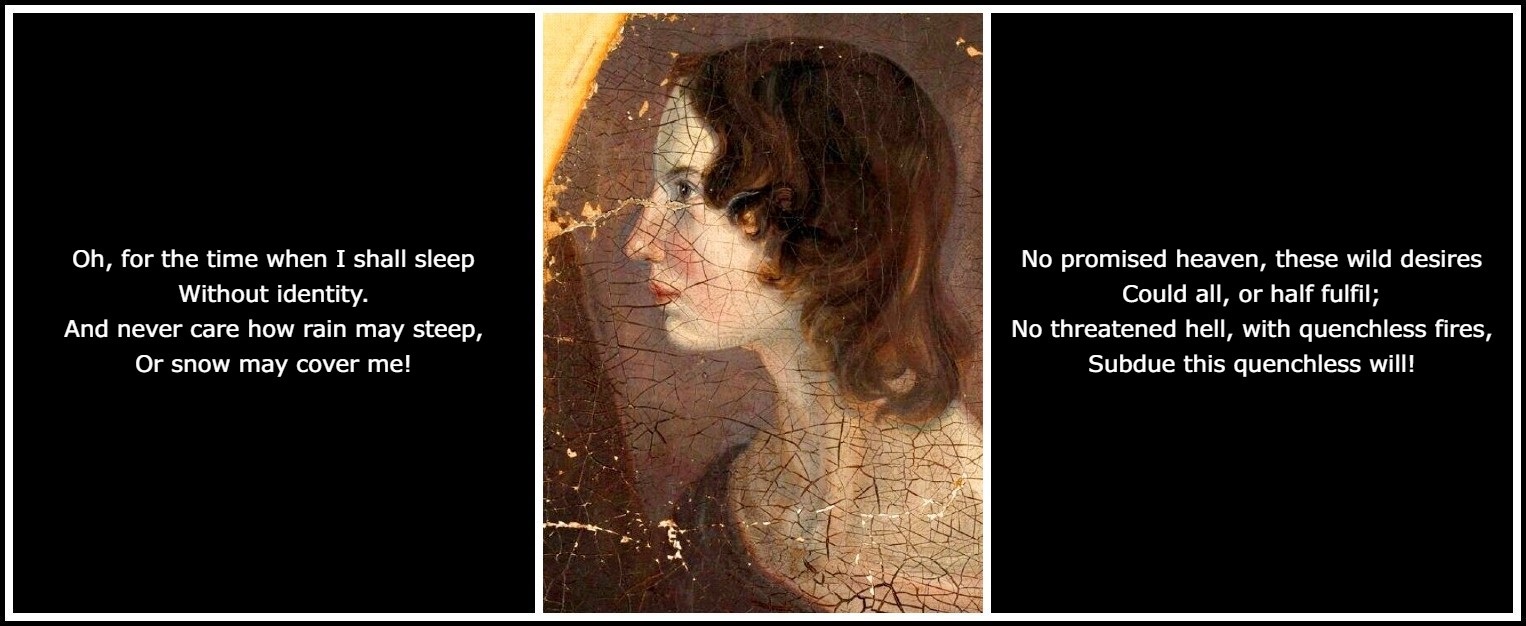
Emily Brontë, Poem No. 181, Second Stanza
Perhaps one might justly say of all the Brontë sisters’ heroines that they are ‘quenchless’ in the sense of Emily Brontë’s verse above, but Wuthering Heights is unique even among Brontë novels as a construction of identity as a craving will which is both insatiable and unsubduable. As if they were a gloss on Wuthering Heights, the wonderful lines by Emily Brontë above seem to propose a Brontëan concept of self: if no Heaven could fulfil the insatiable desire of the poem’s persona, neither could Hell quench the unsubduable will. Both Desire and the Will to act on Desire are seen here as ‘quenchless’, too strong to be either completed or repressed. The alliance of these two, whose strength is the hallmark of individual identity, forms an essentialist view of selfhood, in which a ‘real’ self, a more genuine inner core, is felt to lie buried beneath a distorting layer of social behaviour, values and roles. It would seem, in the social/historical context of Victorian England, that the unfulfilled lack in which Desire originates might easily be associated with the conventional notions of the feminine, and the self-determining practices of an indomitable Will viewed as correspondingly masculine, but this poem unites the two in one selfhood unmarked by gender. But Wuthering Heights is not unmarked by gender; its sexual story is the context for the disclosure of a crisis of female selfhood. Sexuality itself is constituted in the textual body of its two heroines, Catherine Earnshaw and her daughter, Catherine Linton. But just as the feminine is a fluid, multiple social construction, Wuthering Heights is a novel framed by multiple, contradictory voices, each of which subverts the authority of the others, so that no one voice is ultimately privileged, as no one view of selfhood or gender is endorsed.
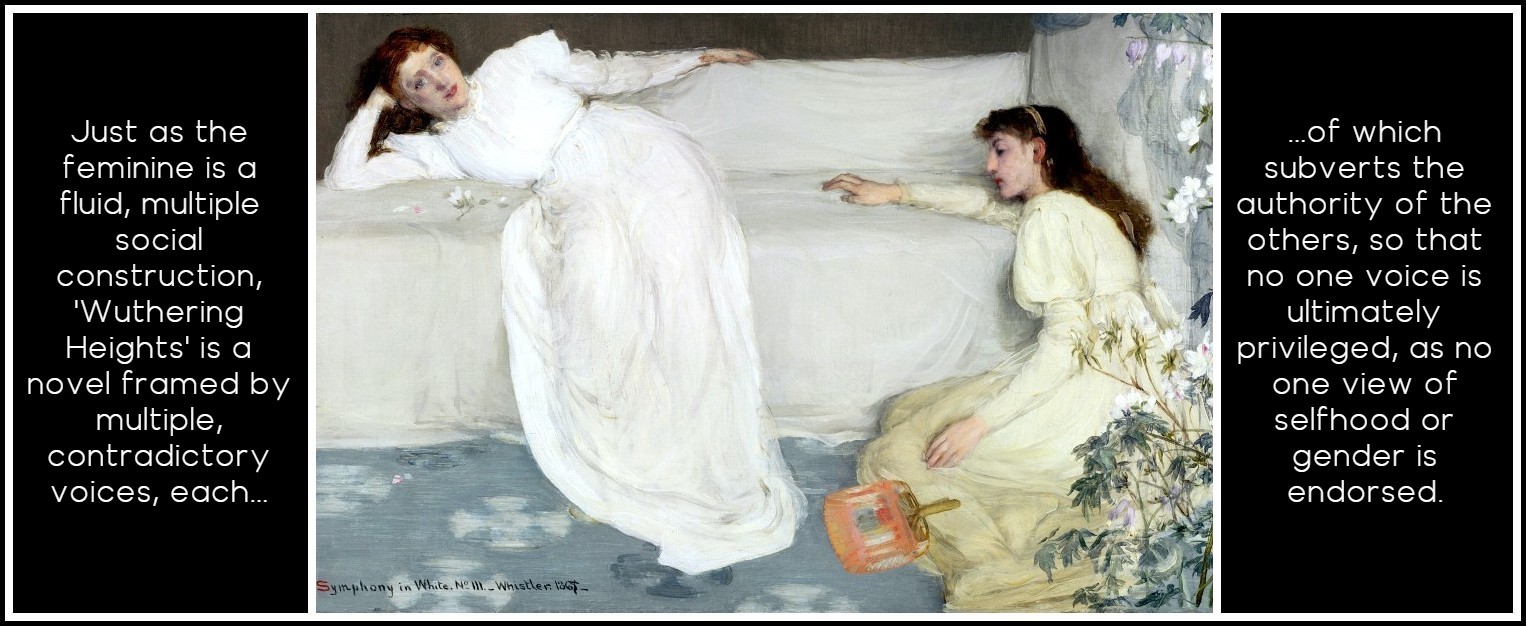
James McNeill Whistler, Symphony in White, No. 3, 1867
Catherine Earnshaw, heroine of Wuthering Heights, does not merely hear a rumour of Coventry Patmore’s ‘promised Heaven’; she insists on the validity and immediacy of her own heaven—which in turn is clearly not the Christian heaven about which she dreams her dream of loss and estrangement. Catherine, who is not so much a ‘craving vacancy’ as a dynamo of the ‘wild Desires’ alluded to in the poem above, is Emily Brontë’s most discomforting answer to the question that obsessed so many Victorians: ‘What is a woman?’ Wuthering Heights is at once a continuance of the search for an answer to this problem, and an anomaly in the quest. The passivity and will-lessness of Moral Femininity,1 for example, do not have the same value here in as they do in Charlotte Brontë’s novels. Whereas Jane Eyre typically longs to ‘repose on what I trust’, i.e. her lover, it is difficult to imagine Catherine Earnshaw reposing at all, even in the prison-frame of her body after death. Conversely, Catherine is much more capable of being the Lady, by birth, physical attractions and temperament than Jane Eyre or Lucy Snowe, and this possibility is more of a critical issue here than in either Jane Eyre or Villette. If sexual love promises identity to the ego-deprived heroines of Charlotte Brontë’s novels, enmeshed as they are in the moral possibilities of selflessness, Catherine appears to have been born with a strong sense of selfhood, which she is only too careless about risking.
1 – One of the mythic paradigms of women’s sexuality in nineteenth-century British literature is one I call Moral Femininity, in which a heroine is empowered and achieves self-definition by restraining her own strong desires, as well as those of her lover. Yet in Wuthering Heights, this particularly ‘womanly’ power to change the social order is seen as problematic, and another view is represented in tension with the first: to repress female sexual desire is to forfeit some essential measure of female selfhood and autonomy.
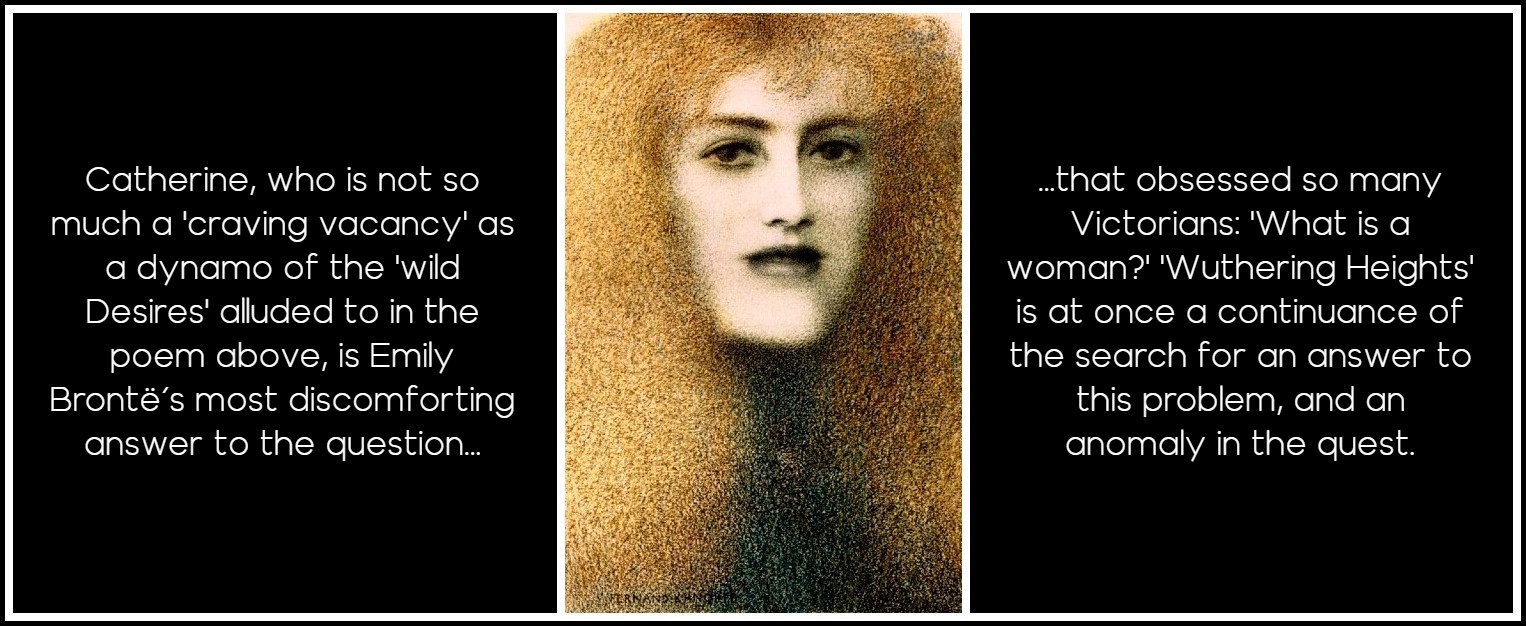
Fernand Khnopff, Red Lips, 1897
Yet what she risks and what is at stake is highly problematic. As in Jane Eyre, the heroine is attracted to a man of implacable and relentless will, a man eager to, as Catherine says, ‘seize and devour’ a woman; yet a significant element of the story is that this same woman has, through the promise of sexual love, a certain mastery over him. If in Charlotte Brontë’s novel, ‘the heart’ opposed the sexual outlaw, in Wuthering Heights the heart is the sexual outlaw. As in Clarissa, where the problem of sexuality focused on the modern dilemma of the Christian will in a society based on self-interest, sexual love in Wuthering Heights has assumed a burden of so much meaning that it must either sink beneath the weight or rise above it. Thus we have the well-known tantalizing ‘metaphysical’ or ‘spiritual’ aura of Wuthering Heights, which is more puzzling than Richardson’s resolution of sending Clarissa to Heaven. Wuthering Heights consigns the Christian Heaven mainly to the decent conventionalities of Nelly or the absurdly anti-human pieties of Joseph, while the chief protagonists, like the persona of the author’s poem, dismiss ‘promised Heaven’ and ‘threatened Hell’ as entirely inadequate and irrelevant to the urgencies of the ‘quenchless’ sexual will. Instead, this novel works in terms of ‘my heaven’, as Heathcliff describes his first principle, in which sexual love forms the dangerous border crossing between individual freedom and the Hell of isolation.
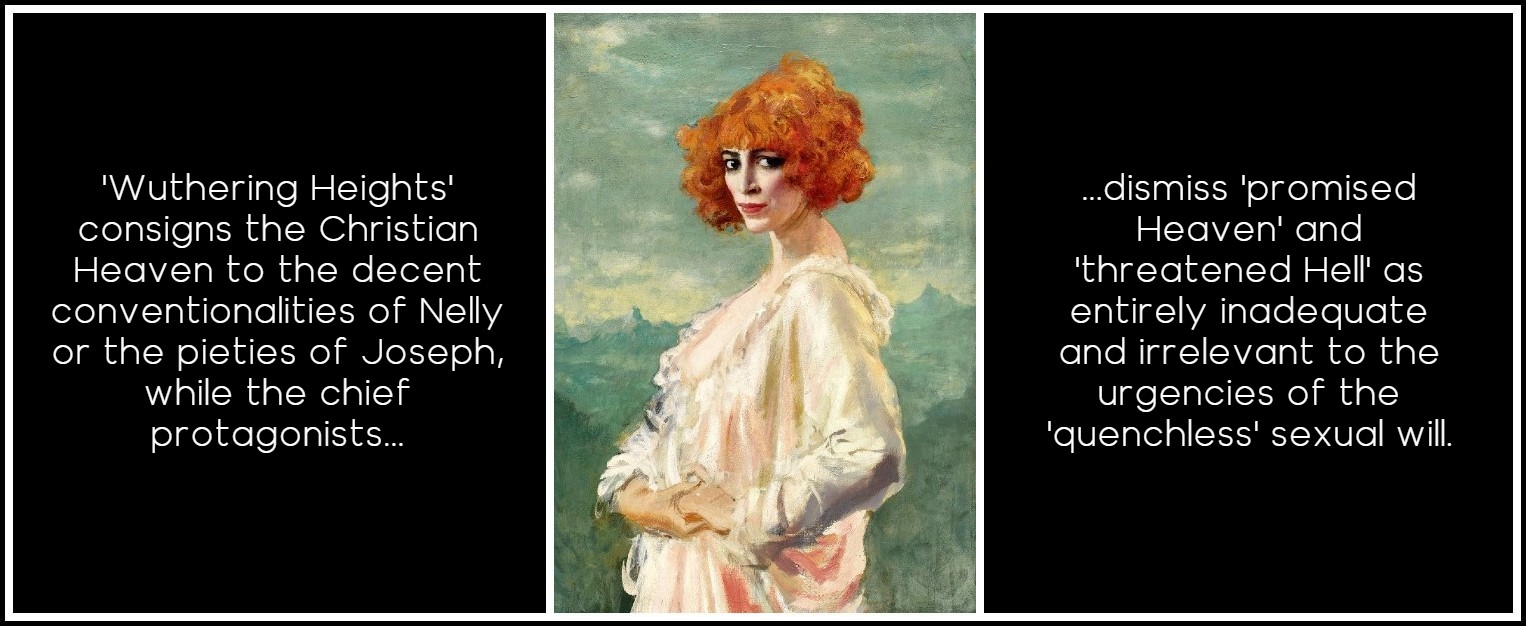
Augustus John, The Marchesa Casati, 1919
Of all the many mysteries of Wuthering Heights, the nature of the love between Catherine and Heathcliff is the most difficult to penetrate; in a novel about the absolute commitment of the self to love, the text seems to refuse a final commitment to the judgment of love itself as a value. We know their love is ‘wild’ compared to the domesticated affections of the other characters, but the use of this key word is itself fluid: ‘wild’ appears to mean, variously, inartificial as an attribute of nature, as in ‘the wild green park’; uncivilized and lawless, as when Catherine’s sister-in-law warns on her return from the Lintons that ‘she must not grow wild again’; or madly gay-spirited, as when Catherine is called a ‘wild wicked slip’, always singing, laughing and teasing. The multivalent significations of this word allow it at once to indicate the state of violent unruliness in Catherine’s threat ‘I shall get wild’, while poetically implying the largeness of emotion that results only from the letting go of self-control, releasing a living energy that permeates a ‘world awake and wild with joy’ which is the second Catherine’s idea of heaven. The result of this ambiguity of language and the famously unreliable narrative frame is a challenge laid down, not only to each of the characters, but to the reader as well, to penetrate an obscure and refractory truth. We are left, like a heroine of sensibility, to ‘feel’ what is right, reduced to a ‘heart’ in moral perplexity.
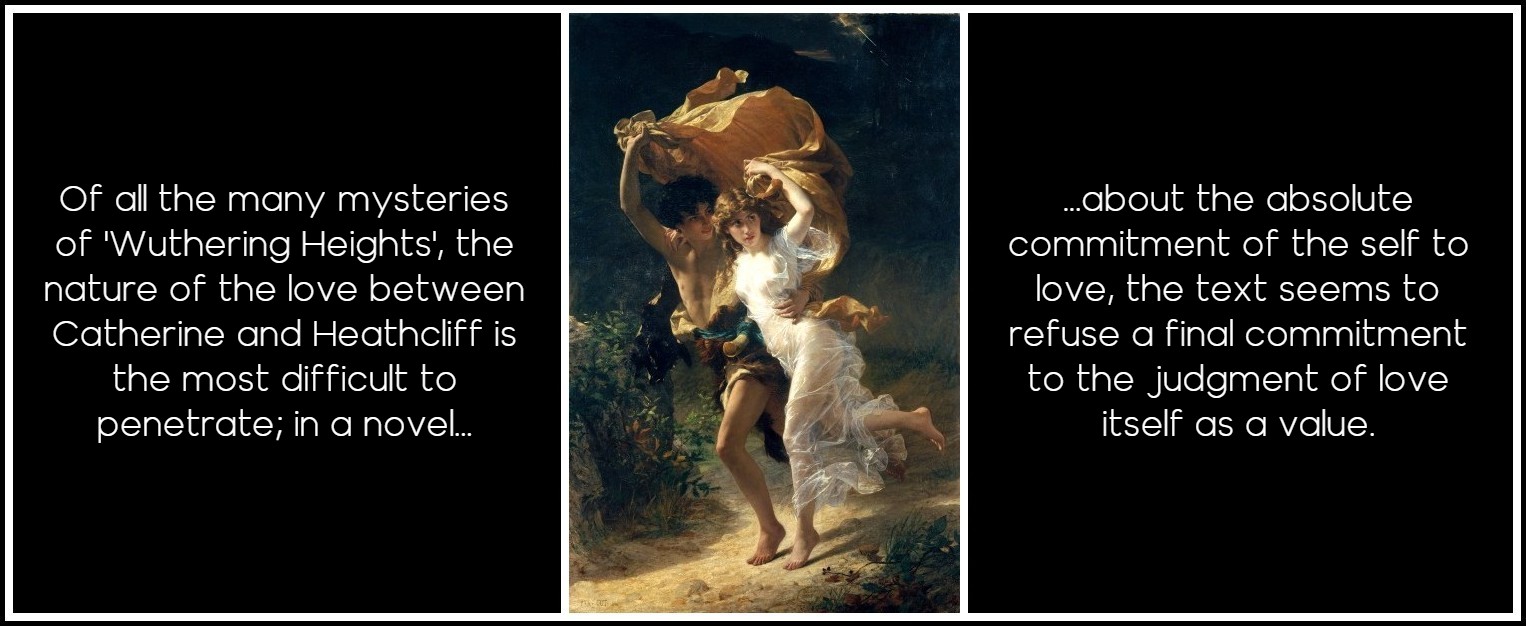
Pierre-Auguste Cot, The Storm, 1880
Wuthering Heights has most often been taken as romanticism at its peak, an idealization of love carried, as J Hillis Miller says, ‘as far as it can go’. Yet this novel employs all the high feeling of romantic love even as it strenuously subverts it as an ideal. Throughout the novel, conventional romantic love is consistently pilloried, from the narrator Lockwood’s self-styled and painfully self-conscious ‘romantic’ view which childishly desires only what it may not have, to the inflated and self-deceiving infatuations of Catherine for Edgar, Isabella for Heathcliff, and the second Cathy’s for Linton. The idea that romantic love is noble and unselfish by nature, as Charlotte Brontë herself had tenaciously insisted, is everywhere held up to ridicule. Heathcliff himself scornfully appraises the narcissistic quality of Isabella’s ‘delusion’, in which she pictures in him ‘a hero of romance expecting unlimited indulgences from my chivalrous devotion’. Similarly, Hindley and his wife Frances, who together form a small, self-sufficient ‘paradise on the hearth’, in Catherine’s own contemptuous words, are conventionally loving and domestic yet entirely selfish in their self-absorption. Their mutual indulgence makes them not more benevolent to others, but less so: on Sundays they ‘basked downstairs before a comfortable fire’, according to Cathy’s journal, ‘kissing and talking nonsense by the hour’, while the other members of the household are banished to a conveniently distant ‘congregation in the garret’. There is not, until perhaps the final pages, a feminine angel in any house in Wuthering Heights, though the image of the selfless angel hovers over this novel as ceaselessly as the spectre of the nun haunted Villette.
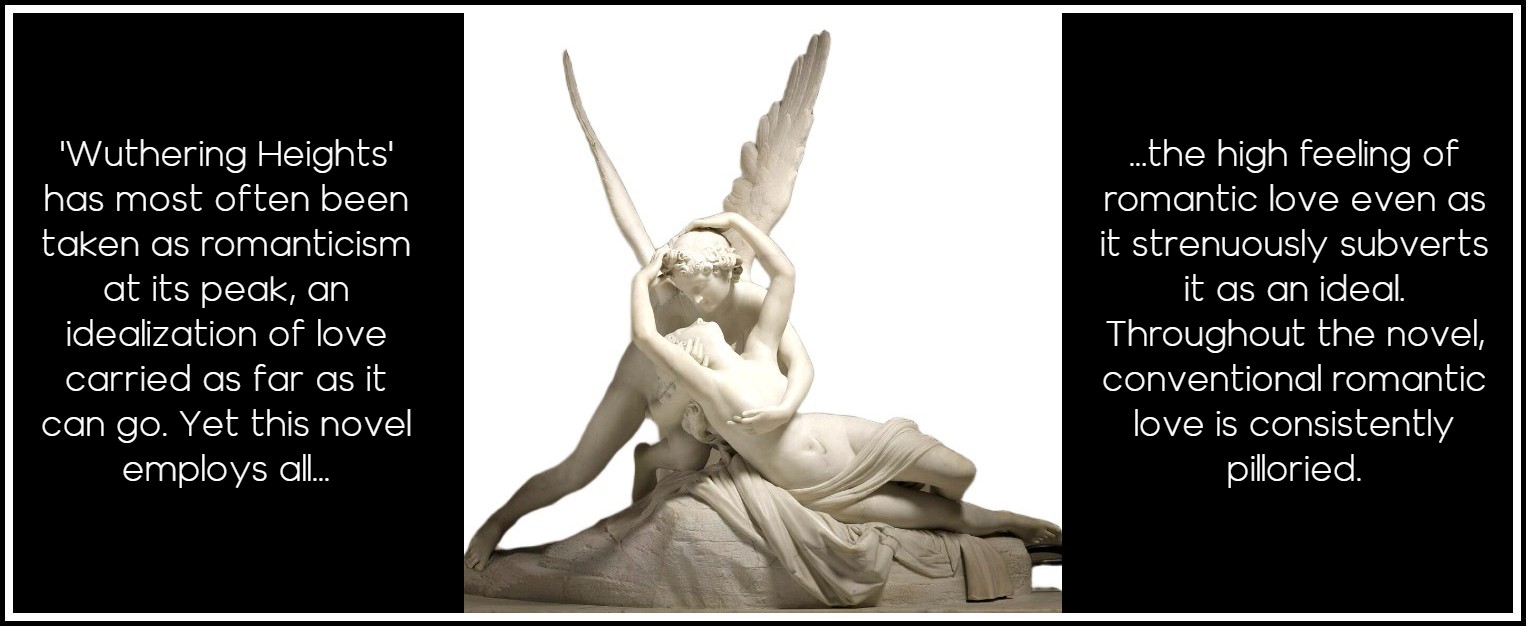
Antonio Canova, Cupid and Psyche, 1794
In the mid-Victorian period the exact relationship of romantic love to sexual desire was so equivocal that an ideology of ‘love’ could be appropriated by both sides, readily identified either with conventional social striving and the selfishness of individual interests, or as a noble revolt by the individual against this social mode. This ambiguity, normally handled coyly or sentimentally in popular Victorian literature, is particularly confusing in Wuthering Heights because of the startling oddness of Catherine and Heathcliff’s relationship. It would seem, in order to deal with this doubleness in the novel, that we as readers are forced (not least by Cathy herself) to make distinctions between ‘romantic love’ and ‘sexual love’, or even more perplexing, between both of these and a third, vaguely metaphysical concept, ‘real’ love. Such convenient categories, however, merely confuse the issue by begging the basic question: what is the moral status of sexual love? Is it still another form of possession in a society ever striving for more possessions? Or is it a rebellion of two against worldly values, one large and deep feeling both criticizing and substituting for the web of social relations? Is its heightened emotion an excuse for a more subtle form of exploitation, or is exploitation rather sexual possession without feeling? This, I would argue, is the pivotal issue on which Wuthering Heights turns, concealed by its peculiarly Victorian striving after balance and conciliation.
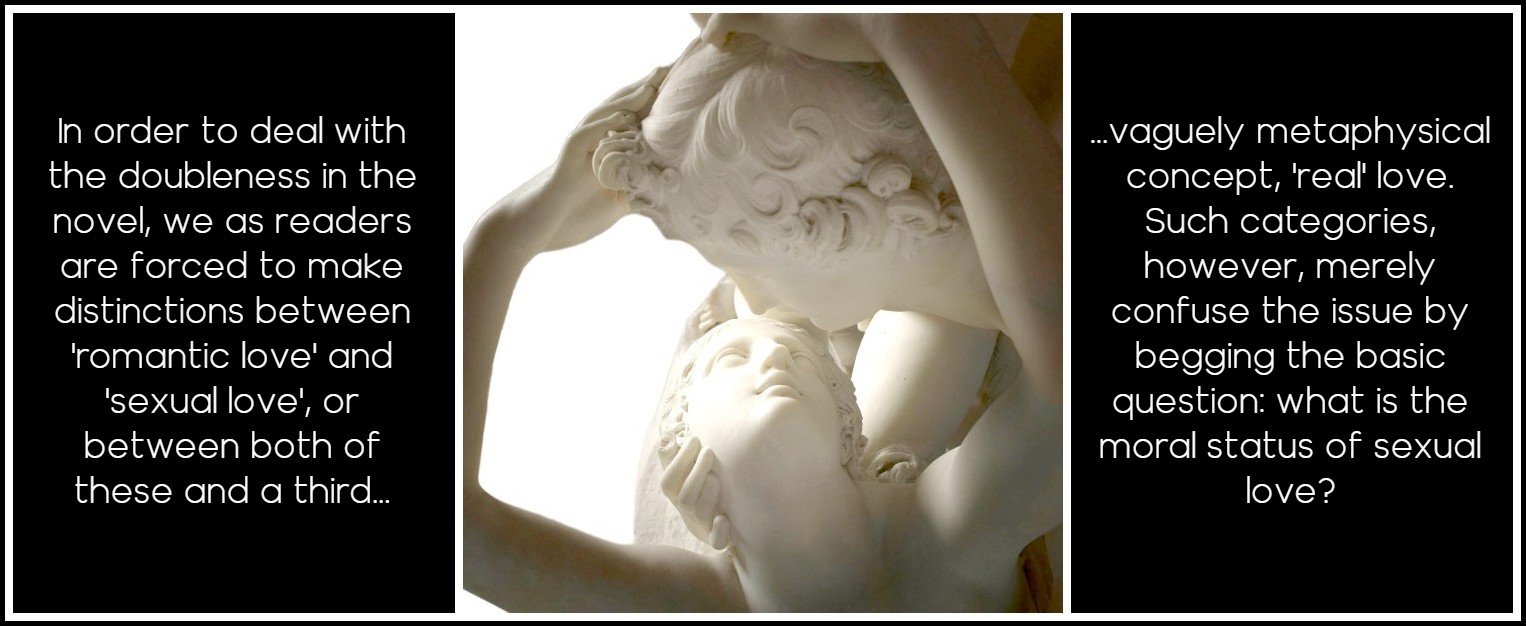
Antonio Canova, Cupid and Psyche, 1794 (detail)
Early critics of the novel generally took one extreme position or other: Catherine and Heathcliff were at first seen as sexual monsters, later as idealized romantic heroes. According to the first position, Heathcliff’s shocking rejection of Christian dogma, whose ‘promised Heaven’ and ‘threatened Hell’ appear in the novel as entirely inadequate to the urgencies of ‘quenchless’ sexuality, rendered him coherent only as a malignant dynamo of uncontrollable ‘wild Desires’. The second critical perspective, beginning in the late nineteenth century, saw the fulfilment of sexual love as interchangeable with the attainment of individual freedom through the release of repressed Desire/Will, and the banishment of the Hell of the self’s isolation. In much twentieth-century criticism, however, the novel has been viewed as either a darkly sinister sexual story or else not ‘really’ related to sex at all, either reeking of incest and sadism or else purely spiritual-metaphysical in its concerns. All of these critical perspectives tended to mystify the character of Catherine as an incoherent subject, a woman with a strong will and an unrestrained desire. The very abundance and variety of opinion on the novel is itself suggestive: when so many critics strain so hard, surely some highly disturbing (and provocative) element is present in the text itself.
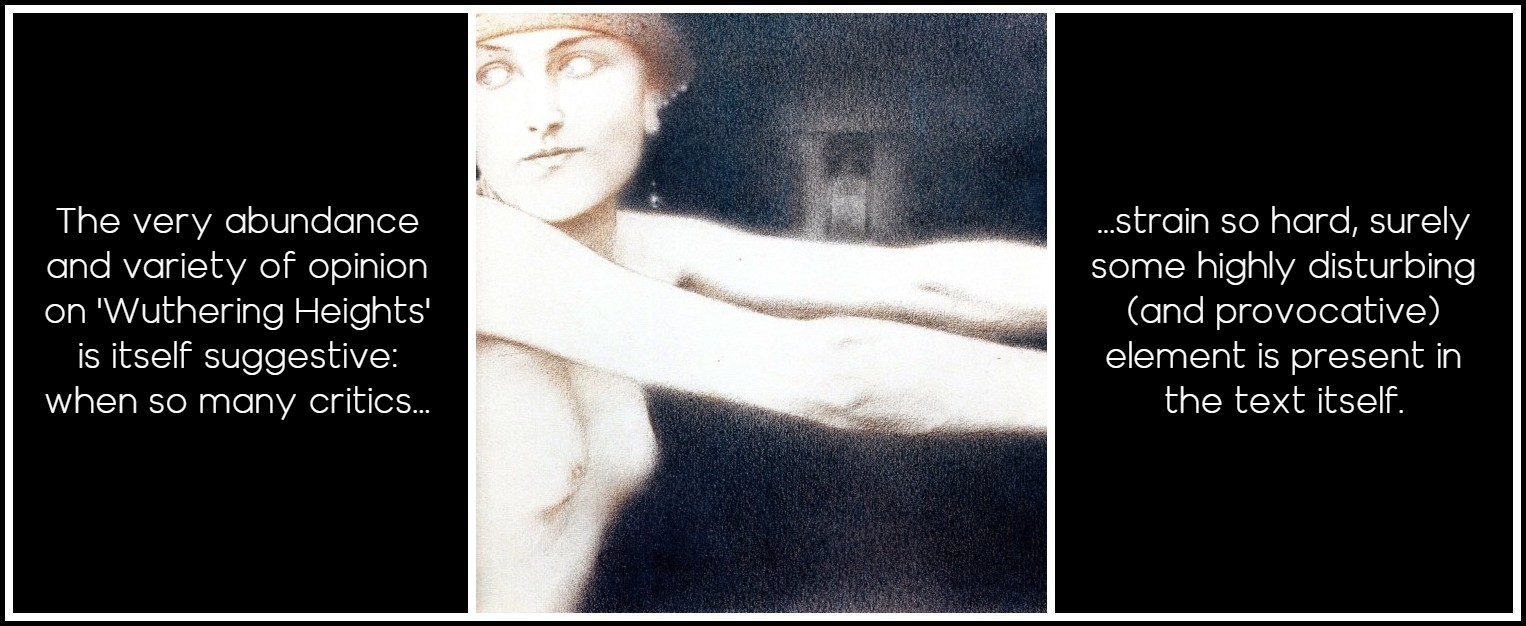
Fernand Khnopff, Study of a Woman, 1895
It is difficult to avoid the conclusion that Brontë herself cultivated this disturbing element: from Catherine’s famous confession speech to Nelly, in which she gropes for words to describe her feelings—‘I cannot express it’, she tells her companion—and merely alludes to a dream she is not permitted to disclose, to the last intense moments of her life, Catherine never articulates the ‘true’ relation she desires with Heathcliff. Most confusingly, while we are taught by the text how to feel with the first Catherine, a superabundance of contradictory signs leaves us confused as to what to think of her as a woman. Traditionally, critics saw her as Nelly Dean speaks of her, a perpetrator of the tragedy; more recently, some have allied themselves with Catherine’s own view of herself as victim. In the end, the textual representation of Catherine herself proves to be the most obscurant of all barriers to the privileged story of Wuthering Heights, the illusory Ur-story, whose telling is always being postponed. We are offered partial truths, biased truths and a series of interconnected fragments which never complete the whole story, but direct knowledge of Catherine’s inner self is withheld from us, like the dream which, if Nelly had allowed her to tell it, would ‘explain my secret’, or the contents of the unread books filled with Catherine’s journal, mentioned—again, tantalizingly—by Lockwood.
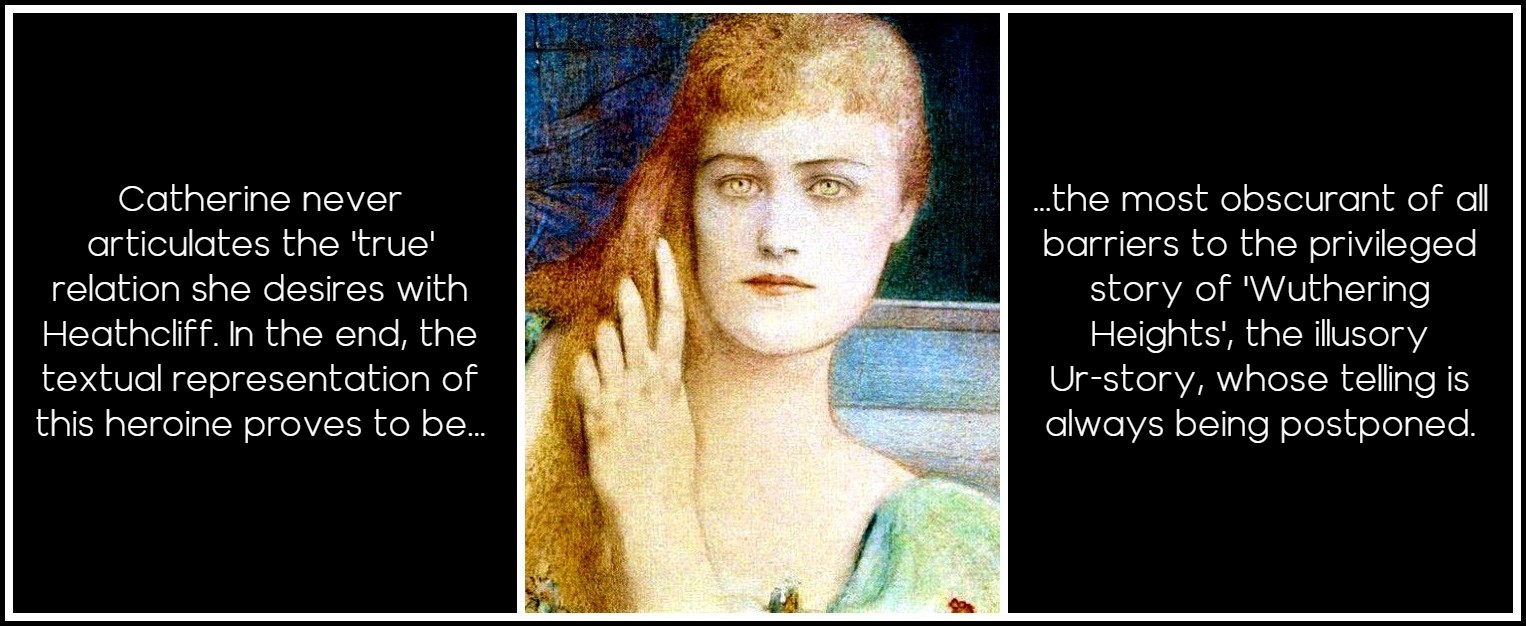
Fernand Khnopff, By the Sea, 1890 (detail)
Though Catherine is clearly spoiled, self-pitying and violent-tempered—‘I’ll cry myself sick!’ she typically threatens—she nevertheless asserts her craving as a positive value. The dangerously wilful, self-centred but attractively passionate male hero is a well-established tradition in literature from Don Juan to Manfred, but our identification with such a heroine is radical in the British novel. It is as though Emily Brontë set out through the character of Catherine to mortify the sweetness of popular romantic love and the fragile Moral Feminine, in much the same way that Charlotte Brontë did the convention of the beautiful and dashing Lady-heroine with the plain Jane Eyre.
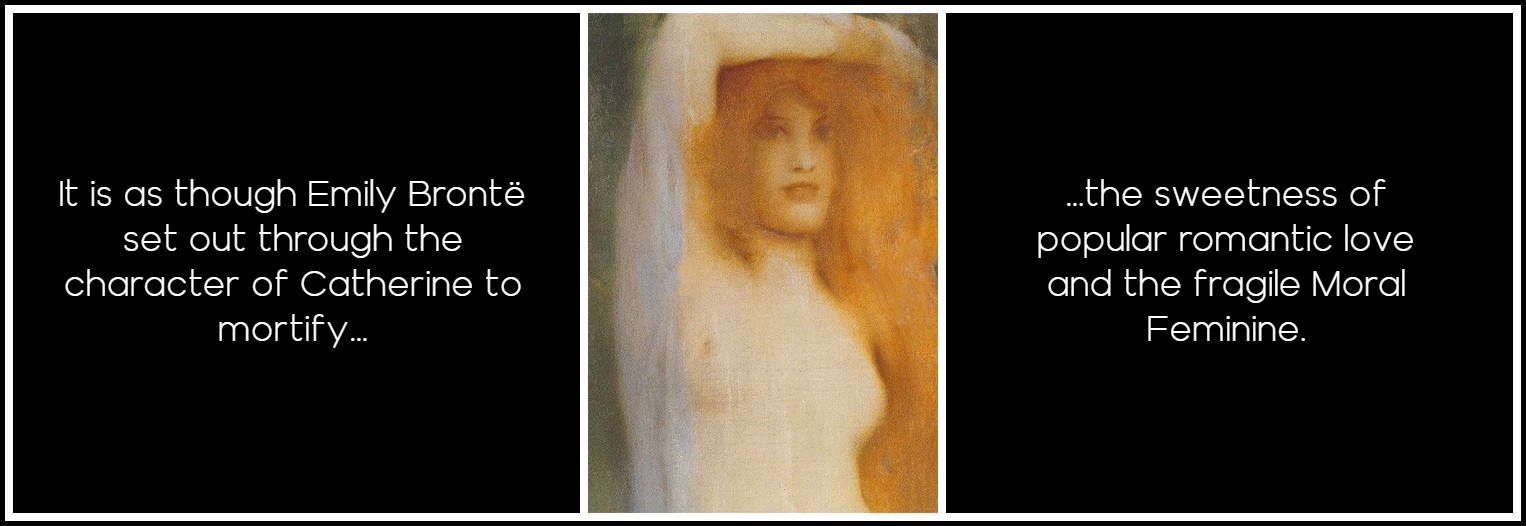
Fernand Khnopff, Acrasia Faerie Queen, 1892 (detail)
It has become a cliché of Brontë criticism to assert that the relation of Catherine and Heathcliff cannot survive into adulthood because it is essentially childlike, meaning, as critics have generally used the term, asexual or pre-sexual. I would argue that it is doomed because it loses its unique sexual status, which was childlike in the metaphorical sense of pre-social and unselfconscious. The relation of Catherine to Heathcliff has been disturbing or exhilarating to generations of readers and critics, not merely because it is impossibly romantic and obsessive, and/or possibly supernatural—there is, after all, much literary precedent for both—but because it discloses a uniquely visionary view of female sexuality in the very midst of an otherwise expectable construction of feminine character. Certainly Catherine Earnshaw is no ordinary Victorian heroine, even by the unusual standards set by the author’s sister, Charlotte Brontë, whose suffering, desiring heroines—Jane Eyre, Caroline Hedstrom, Lucy Snowe—obsessively consider the moral implications of their acts. She is, of course, still less the Victorian domestic ideal (though at Heathcliff’s return she confidently declares, in one of the nicest ironies of the novel, ‘I’m an angel!’). When she craves, it is not because she is a weak vessel, but from the sureness of a strong will. There is none of the sweetness or passivity of the conventional Moral Feminine about her, willingly suppressing her own sexual desire in order to uphold a social standard or a moral position.
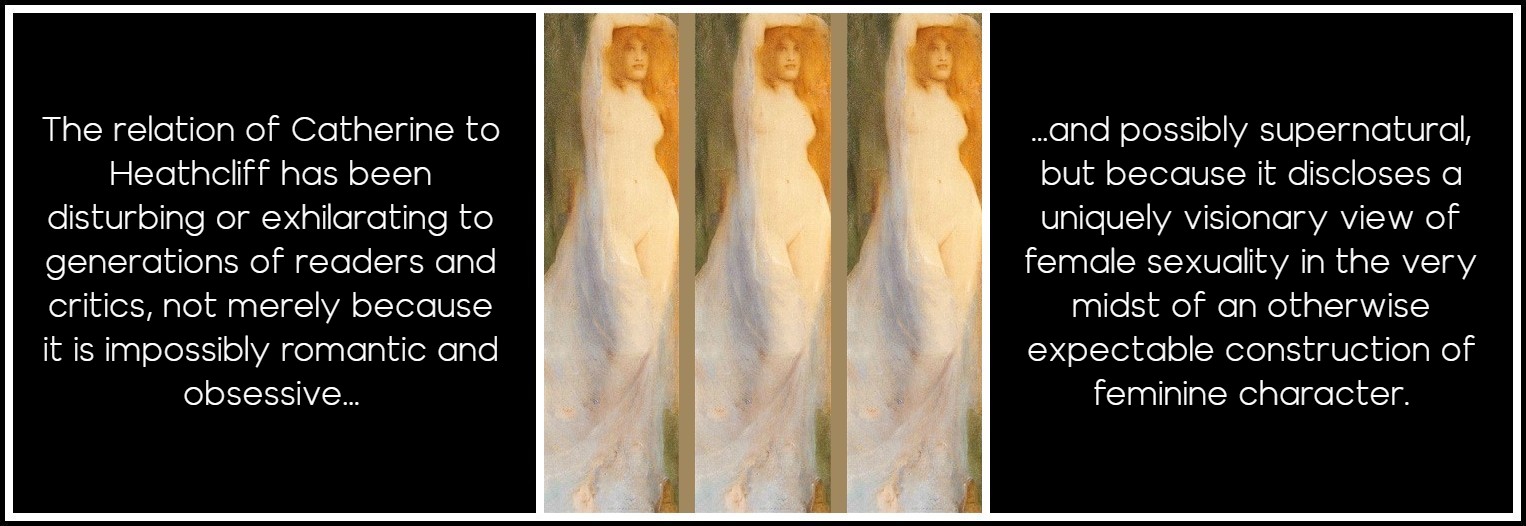
Fernand Khnopff, Acrasia Faerie Queen, 1892
Yet it is easier to say what Catherine Earnshaw is not than what she is. Though it is important in the novel that the child Catherine is a female in a motherless household (Heathcliff fills, we remember, a ‘gap’ left in the family by the death of a male child), yet she is neither entirely enclosed by conventional femininity, with its limited social modes and repertoires of behaviour, nor by a traditionally ‘masculine’ model of identity through action. While partaking on occasion of both, she does not fully live her literary life in either one. Unlike many Victorian heroines, Catherine is represented from the moment we first encounter her in the novel as a rebel, and a comparatively successful one at that. Almost the very first words we hear from her are an unhesitating ‘H. and I are going to rebel’. Catherine recounts in her writing the story of their oppression by her tyrannical older brother Hindley as though confident that someone, somewhere, will want to redress her aggrieved sense of wrong. She projects her imaginary audience, then, out of a sense of injustice (like Jane Eyre’s), directly appealing to the reader’s imagined capacity for sympathy. All narrators do, of course, and both Lockwood and Nelly’s accounts will vie for that sympathy, but the journal of a child has a particular narrative force in that it combines a striking conviction of the immediacy of events with artlessness, sincerity and the appeal of the vulnerable.
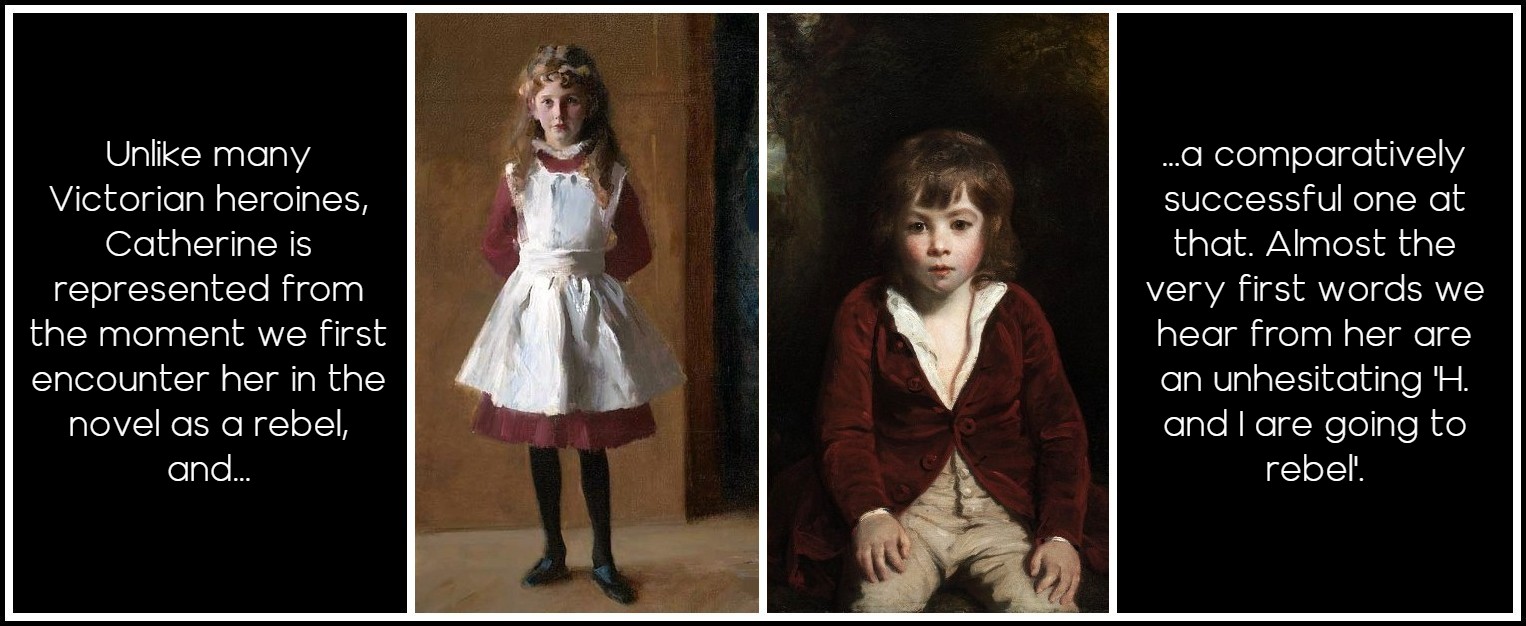
John Singer Sargent, The Daughters of Edward Darley Boit, (detail) 1882 | Joshua Reynolds, Portrait of Master Bunbury, 1781
If the Catherine Earnshaw of this journal is more successful and less self-doubting in rebellion than the child Jane Eyre—she succeeds, for example, in escaping from the kitchen where she has been banished, unlike Jane from her temporary imprisonment—the source of this strength seems to be Catherine’s double identity as an ‘I’ and a ‘we’. So complete, in fact, is the association of wishes, fears and behaviour with Heathcliff that Catherine appears to think of her childhood self as less an ‘I’ than a ‘we’: ‘We took our initiatory step in rebellion’; ‘we should be ashamed’ of talking such nonsense, and so on. Heathcliff is the gun to Cathy’s ‘gunpowder’, her double-barrelled instrument of both aggression and later, ‘wild’ sexual desire, or more precisely, of that originary sexuality which becomes ‘wild desire’ in the context of Victorian containment. Catherine herself, in a later moment of deep mental distress, describes her girlhood as ‘hardy and free’. In fact, as Catherine participates in both her own selfhood and Heathcliff’s (i.e. the famous ‘I am Heathcliff), she seems in one sense to have escaped the constrictive social bonds and limitations of gender. Yet she is not free, as the text itself is never free, from the implications of gender: on the contrary, in another sense Catherine’s self-representation as unsubduable originates in her insatiable desire to ‘be’ both sexes, to enact quenchless Desire and Will at once. The special relation of Desire to the feminine, as feminist critics have pointed out, is that the lack on which it is based is frequently naturalized as a universal characteristic of femaleness. But Catherine (unlike, for example, Jane Eyre or Villette’s little Polly) is not driven by desire in childhood precisely because she does not lack: indeed, she has more than enough. ‘He’s more myself than I am,’ Catherine cries to Nelly at the moment she is about to lose her childhood tie to Heathcliff.
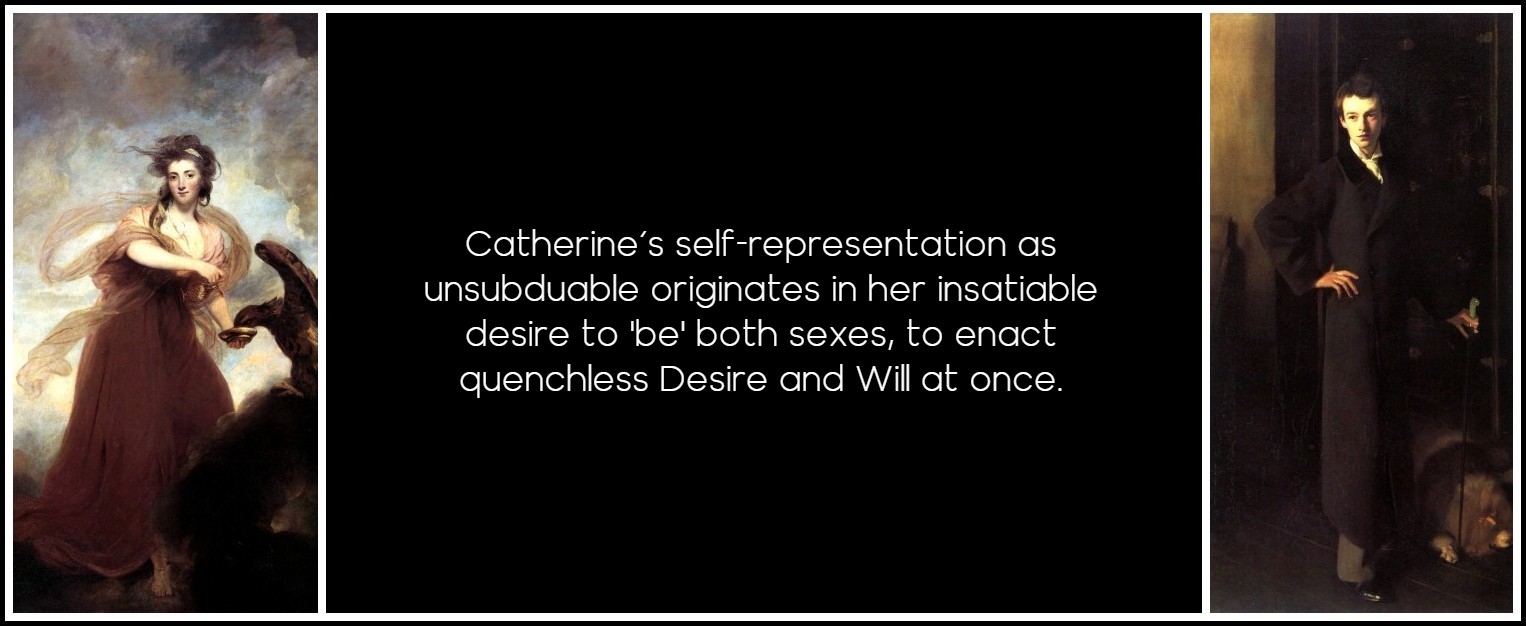
Joshua Reynolds, Mrs Musters as Hebe, 1785 | John Singer Sargent, W. Graham Robertson, 1894
Catherine had already begun to fail in her early bid for our sympathy when she entered the competitive-exploitative world of ladies and gentlemen at age twelve. The crux comes, of course, when she is forced by Edgar’s proposal of marriage at age fifteen to choose between ‘Lady’ and ‘woman’ for her self-identity. Like Jane Eyre, Cathy is placed between alternatively contrasting lovers in such a way that sexual choice appears inextricably involved with moral and social choice. Nelly, for one, however, is quite clear on this point: her motive is that she is ‘full of ambition’, not merely for wealth and social status, but also—perhaps more—for the admiration and devotion of Edgar and Isabella. These are, in Nelly’s significant choice of words, ‘acquisitions that flattered her from the first’. Dress embodies the pretension towards status through prettified surface, and Catherine assumes a ‘silk dress’ and hair artificially curled for the occasion of Edgar’s visits. Similarly, the a priori ‘we-ness’ that formerly made her companionship with Heathcliff egalitarian and unselfconscious is replaced by her irritated sense that Heathcliff has little social conversation. ‘You might be dumb or a baby for anything you say to amuse me, or for anything you do, either!’ she accuses him, thereby betraying the mode of unearned consumption of leisure and goods which is the hallmark of the Lady.
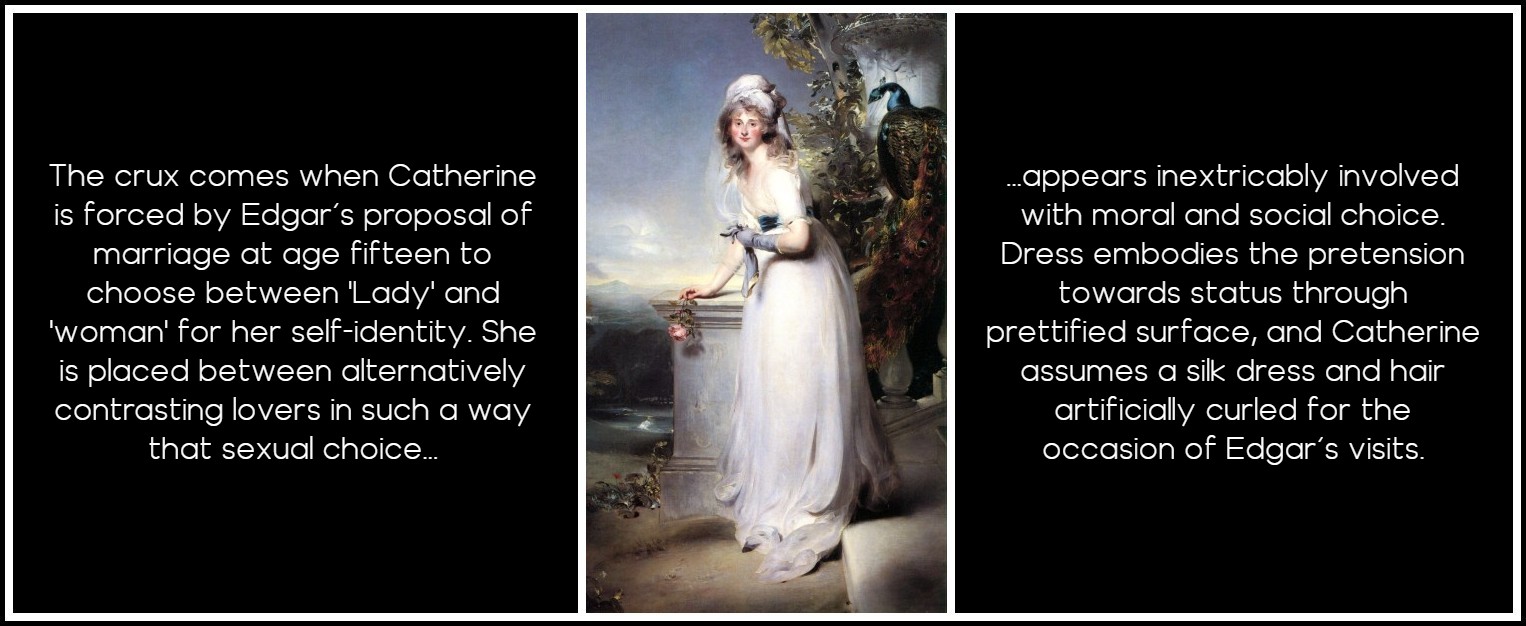
Thomas Lawrence, Catherine Gray, Lady Manners, 1794
Then, too, romantic love in Wuthering Heights, associated with the world of ladies and gentlemen, involves another kind of greed, the wish to find and incorporate an ideal vision of oneself as seen through the eyes of another. We suspect that what the adolescent Catherine really loves in Edgar is the reflected image of herself as a grown-up Lady, one who is adored, petted and indulged, teasingly desirable yet eminently respectable. Ladyhood, the only allowably ‘feminine’ way to be wilful, is the social structure of legitimate female power to which all around her urge Catherine. By contrast, as Catherine describes her feelings, she does not need to attach herself to Heathcliff’s qualities because she is Heathcliff, preternaturally resembling him. The impassioned force of Cathy’s speeches about her two loves tends to overshadow the striking oddity of the terms in which she couches her decision to marry Edgar. After stating clearly that she would have married Heathcliff had not her brother degraded him into a brute socially and intellectually, that their physical and emotional separation is ‘impracticable’, she posits a future relationship between them after her marriage to Edgar which will be an extension into adulthood of their childhood ‘we-ness’, which she sees as pre-sexual. ‘He’ll be as much to me as he has been all his lifetime,’ she answers indignantly to Nelly’s query as to how Heathcliff will bear her desertion.
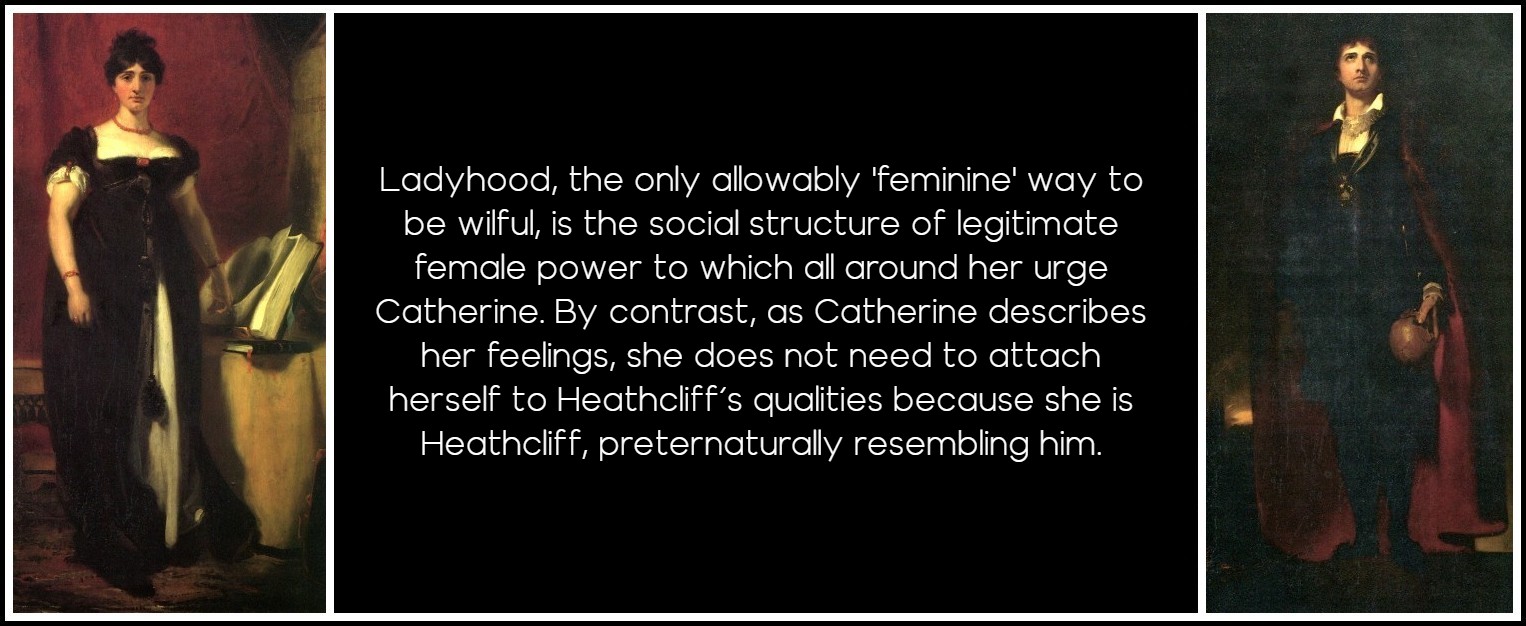
Thomas Lawrence, Mrs Siddons, 1804 | Thomas Lawrence, John Philip Kemble 1801
Her proposal is that they will inhabit the physical world together, necessarily connected in all ways but the sexual, just as they shared one bed as innocent children. Catherine thus treats her own sexuality not as a necessary part of her selfhood—which is, as she herself has defined it, her relation to Heathcliff—but as a commodity to be dangled or concealed, used or denied to obtain social ends when most convenient. Moreover, Catherine believes that this denial of the sexual aspect of her love for Heathcliff is justified by that sympathy which she is able to feel for him alone. In her own view, Cathy sees herself as the Lady who will ‘aid Heathcliff to rise’ both materially and from his ignorant brutality, with her husband’s money and status. The pose that Catherine would assume is, in fact, based on the sentiment of Moral Femininity: that by withholding or denying her sexuality, the woman-as-angel can influence the recalcitrant male and ‘help’ him to rise above his own brutality.
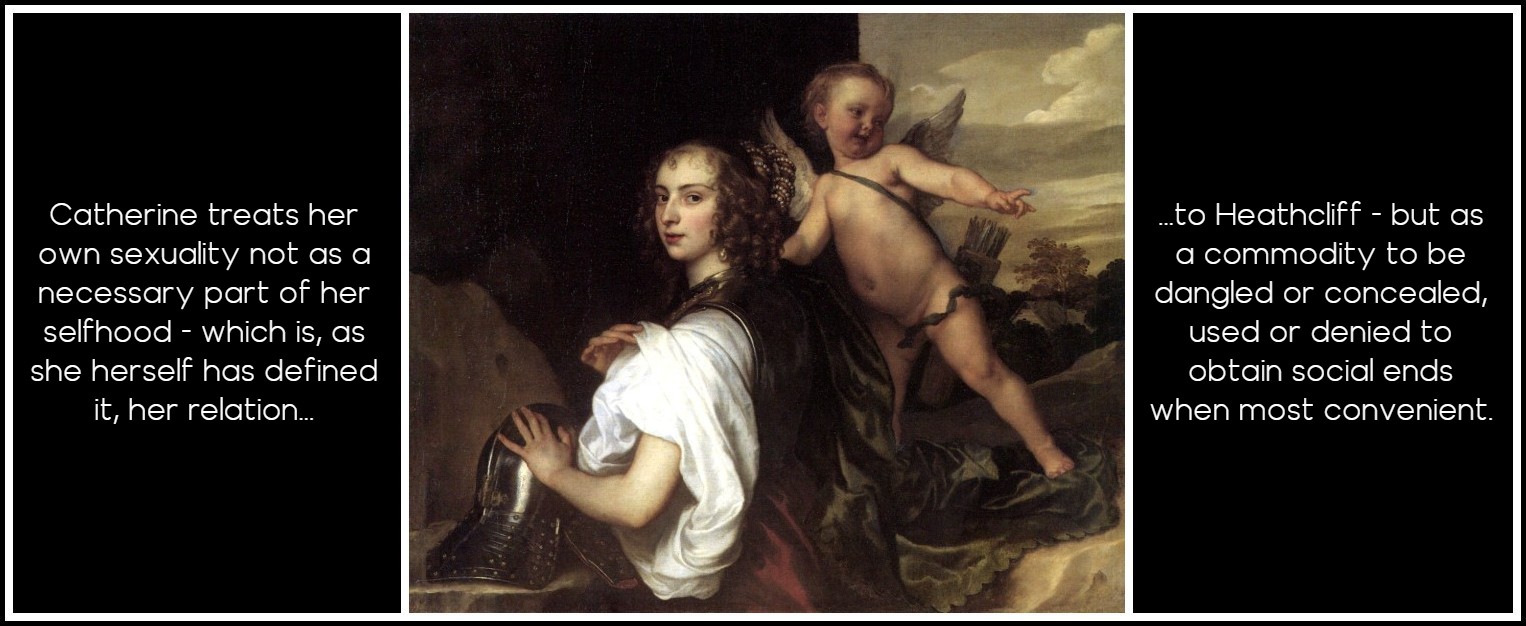
Anthony van Dyke, A Lady as Erminia, Attended by Cupid, 1638
In deciding to marry Edgar, Catherine insists she is going to balance both relations, binding Heathcliff to her while keeping his sexuality at a distance. But Heathcliff is sexuality, or rather he is a figure for sexuality as the essential kernel of her own selfhood, and he therefore must be, at least temporarily, entirely absent to Catherine if she rejects him. Whereas the requirements of a culturally constructed femininity call for the repression of wild, disruptive Desire, the text of Wuthering Heights simply will not allow for mediation between essential identity and femininity, just as conventional romantic love will not accommodate the expression of female sexuality in this part of the novel. When Heathcliff returns after her marriage, Catherine is said to laugh ‘like one beside herself’, as she later is beside herself with madness: the ‘real’ self of Catherine—her secret sexual self, in other words—has returned to haunt her. Trapped between an essentialist definition of female selfhood, constituted by Desire separated from the Will to act on it, and a social definition of femininity, which requires its repression, Catherine can neither bear nor resolve the call to profound sexual experience which her love for Heathcliff implies. Later, self-exiled in her room, we see manifested in Catherine’s delirium a frightening separation of self from self, which Dr Kenneth later calls ‘the danger of permanent alienation of intellect’. In a grotesque parody of the Lady’s manipulative pout, Catherine’s ‘frenzy’ usurps its part, and she becomes frozen in the role she has acted. Now, both physically and metaphorically, Catherine seems ‘beside herself’: ‘Does Edgar know how I’m altered?’ she cries, staring at her mirrored reflection opposite, ‘Is that Catherine Linton?’.
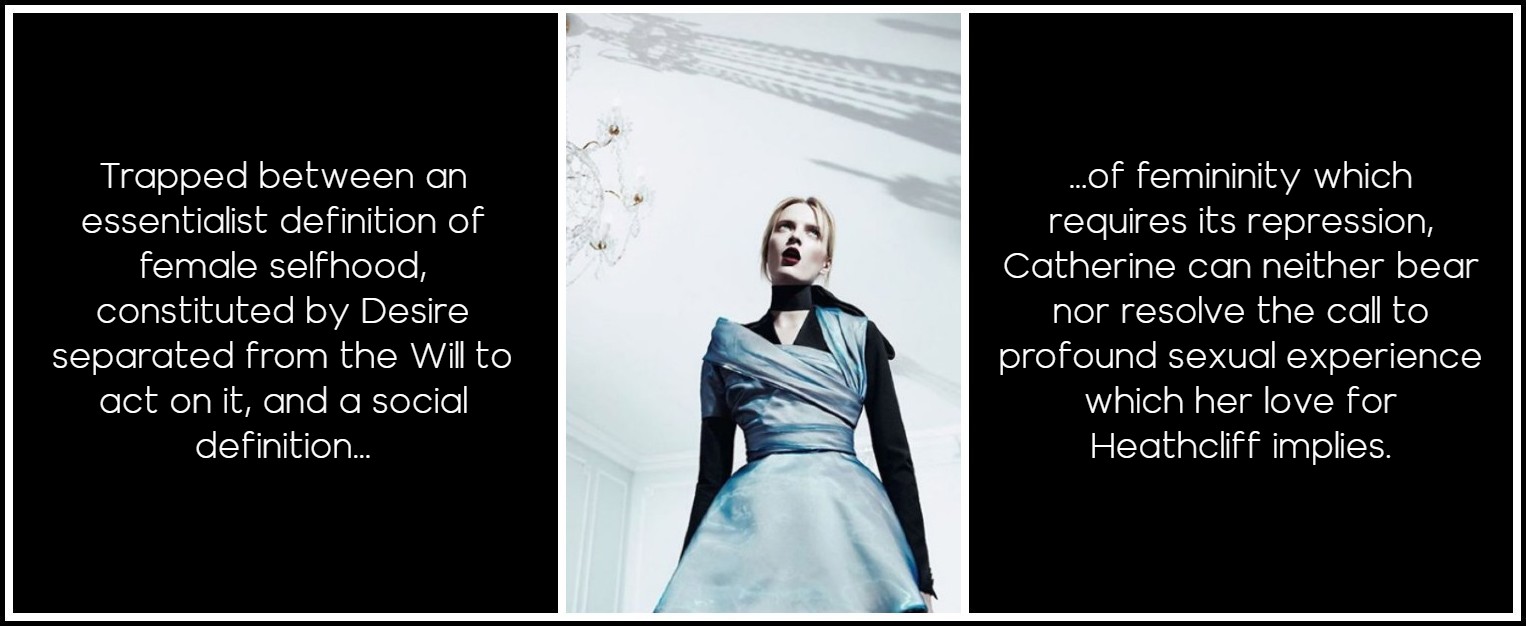
Daria Strokous, 2013 | Photo: Willy Vanderperre
Just as she had confessed to Nelly in her adolescence the recurrent dream that has ‘gone through and through me, like wine through water, and altered the colour of my mind’, her dream of being flung out of Heaven onto the top of Wuthering Heights, Catherine now relates to Nelly a vision, ‘what has kept recurring and recurring till I feared for my reason’. It is the vivid delusion that she is enclosed in her oak-panelled bed at Wuthering Heights, her heart aching with ‘a great grief’: ‘I was a child; my father was just buried, and my misery arose from the separation that Hindley had just ordered between me and Heathcliff—I was laid alone, for the first time.’ She then speaks agonizingly of her wrenching conversion ‘at a stroke’ into ‘Mrs. Linton, the lady of Thrushcross Grange’. Catherine’s new negative definition of her present self, Mrs Linton, as ‘the wife of a stranger; exile and outcast’, derives from the loss of her positive definition of female selfhood in her former relation with Heathcliff. But the choice of her moment of childhood separation from Heathcliff as the emotional turning point of her life seems strangely puzzling in the midst of her crisis of decision between two lovers. Why not remember as the greatest grief, for example, the traumatic scene of Heathcliff’s departure from Wuthering Heights at her decision to marry Edgar?
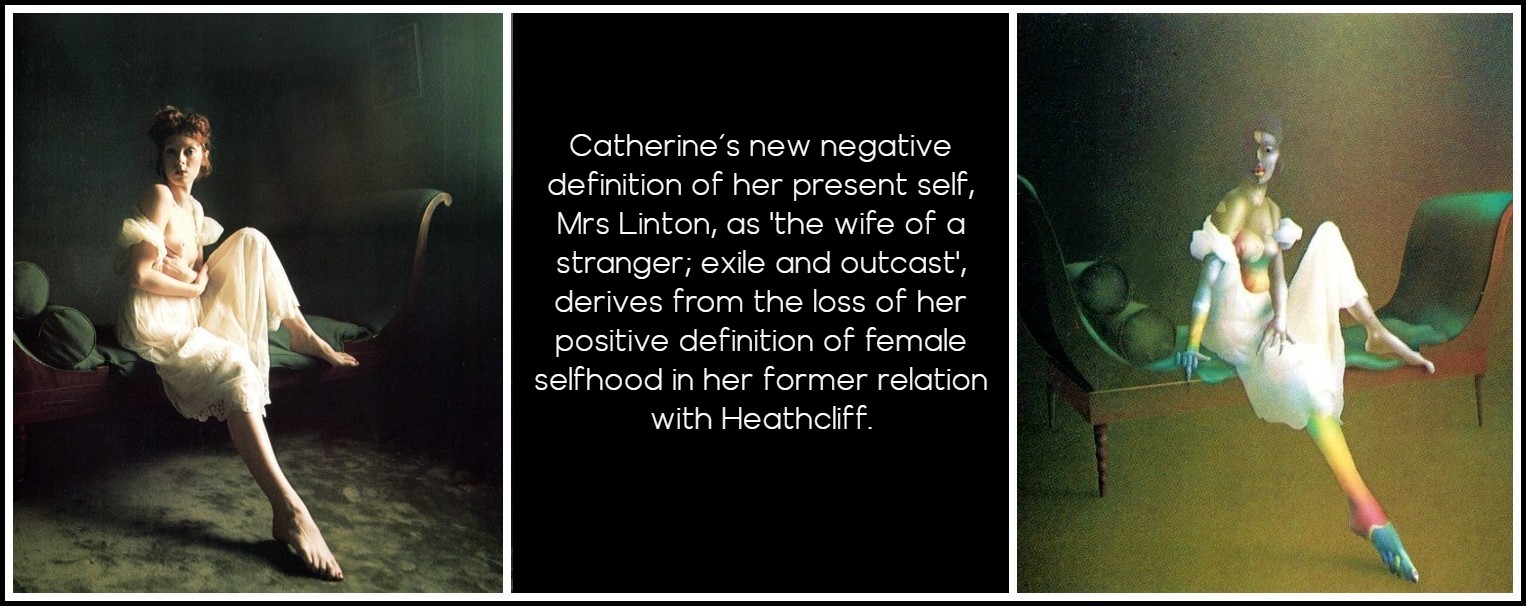
Photo: Karin Szekessy | Painting: Paul Wunderlich
It is here, on the meaning of childhood to Catherine and Heathcliff’s relationship, that so many critical opinions have diverged. It is surely this scene, above all others, of which V.S. Pritchett, for example, was thinking when he wrote that ‘the love of Catherine and Heathcliff is not one of the great love affairs because it is an attempt to get back to their childhood and its sexless companionship.’ One would readily expect to identify Catherine’s poignant memory of childhood loss with a wish to return to childhood’s ‘innocence’, meaning, as most critics have used it, asexuality, but it is worth remembering that the precise scene which recurs to Catherine as her greatest grief is being ‘laid alone’, i.e. Heathcliff’s expulsion from her bed, just as she is about to enter adolescence. I would argue that the emphasis of this scene is not on the negative value of sexuality in favour of an asexual ‘innocence’, but rather on the positive value of sexuality, a visionary sexuality which has its origins in childhood and is a natural extension of Catherine and Heathcliff’s undifferentiated and unselfconscious childhood ‘we-ness’.
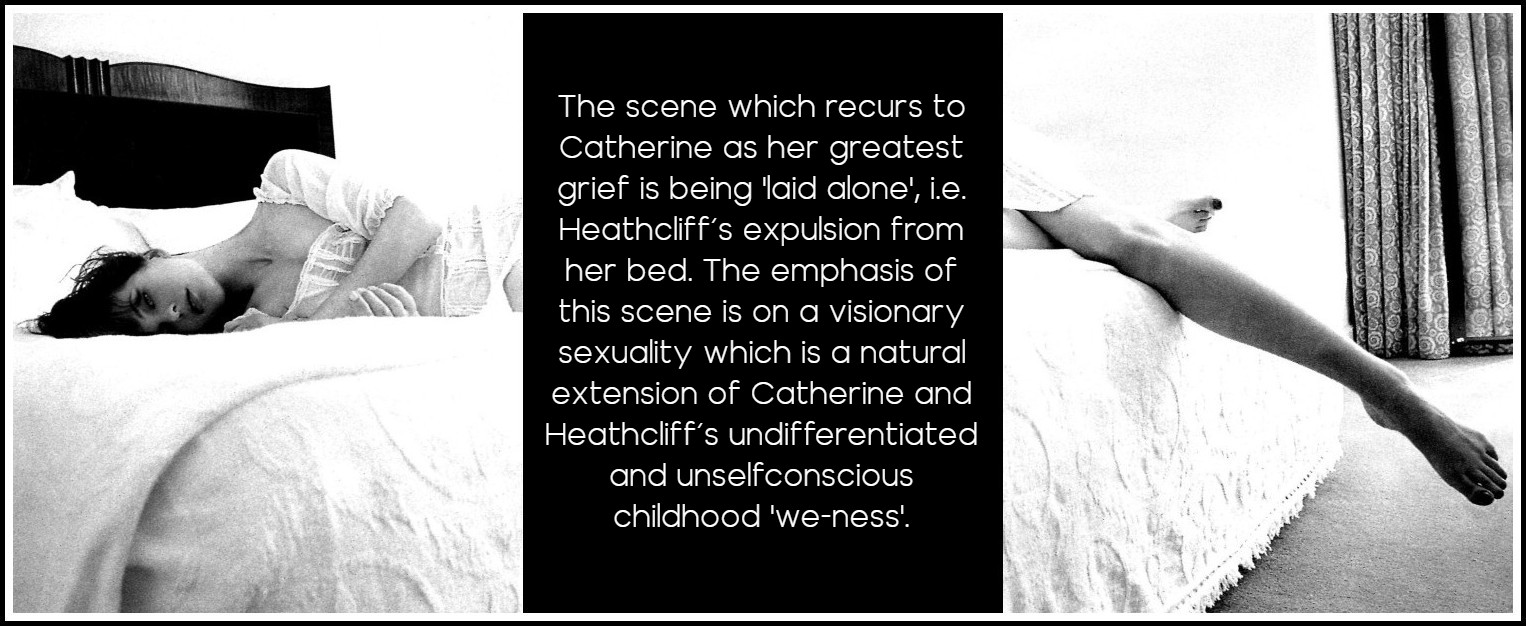
Milla Jovovich, 2003 | Photo: Dominique Issermann
Continued in Part 2 (see image-link under ‘Related Posts’ below)
SUSAN OSTROV: THREE BOOKS
LOVELAND: A MEMOIR OF ROMANCE AND FICTION
CLICK ON THE IMAGE TO GO TO A DESCRIPTION OF THE BOOK
A ‘CRAVING VACANCY’: WOMEN & SEXUAL LOVE IN THE BRITISH NOVEL
CLICK ON THE IMAGE TO GO TO A DESCRIPTION OF THE BOOK
THE GLASS SLIPPER: WOMEN AND LOVE STORIES
CLICK ON THE IMAGE TO GO TO A DESCRIPTION OF THE BOOK
MARA, MARIETTA: A LOVE STORY IN 77 BEDROOMS – READ THE FIRST CHAPTER
A literary novel by Richard Jonathan
RICHARD JONATHAN, ‘MARA, MARIETTA: A LOVE STORY IN 77 BEDROOMS’ — READ THE FIRST CHAPTER
AMAZON & APPLE BOOKS
RICHARD JONATHAN, ‘MARA, MARIETTA: A LOVE STORY IN 77 BEDROOMS’ | AMAZON PAPERBACK OR KINDLE
RICHARD JONATHAN, ‘MARA, MARIETTA: A LOVE STORY IN 77 BEDROOMS’ | APPLE iBOOK
MARA, MARIETTA: A LOVE STORY IN 77 BEDROOMS
A literary novel by Richard Jonathan
RELATED POSTS IN THE MARA MARIETTA CULTURE BLOG
CLICK ON THE IMAGE TO GO TO THE POST
By Richard Jonathan | © Mara Marietta Culture Blog, 2025 | All rights reserved
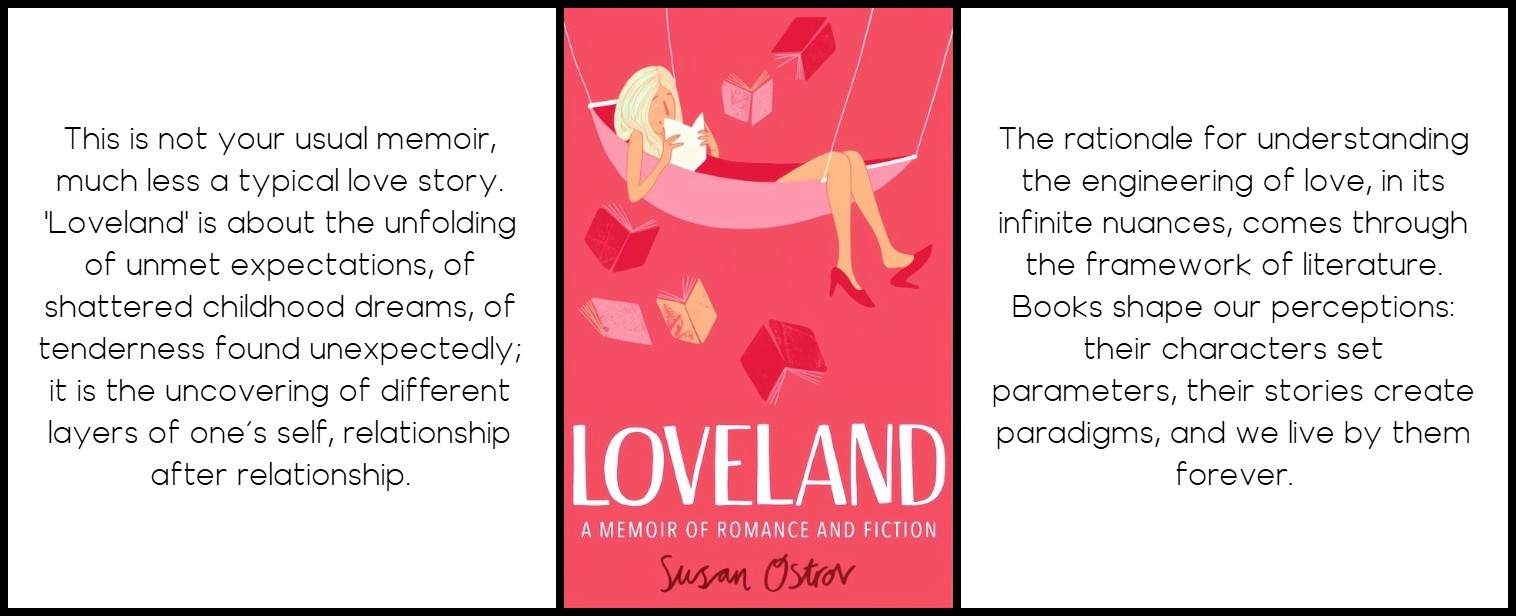
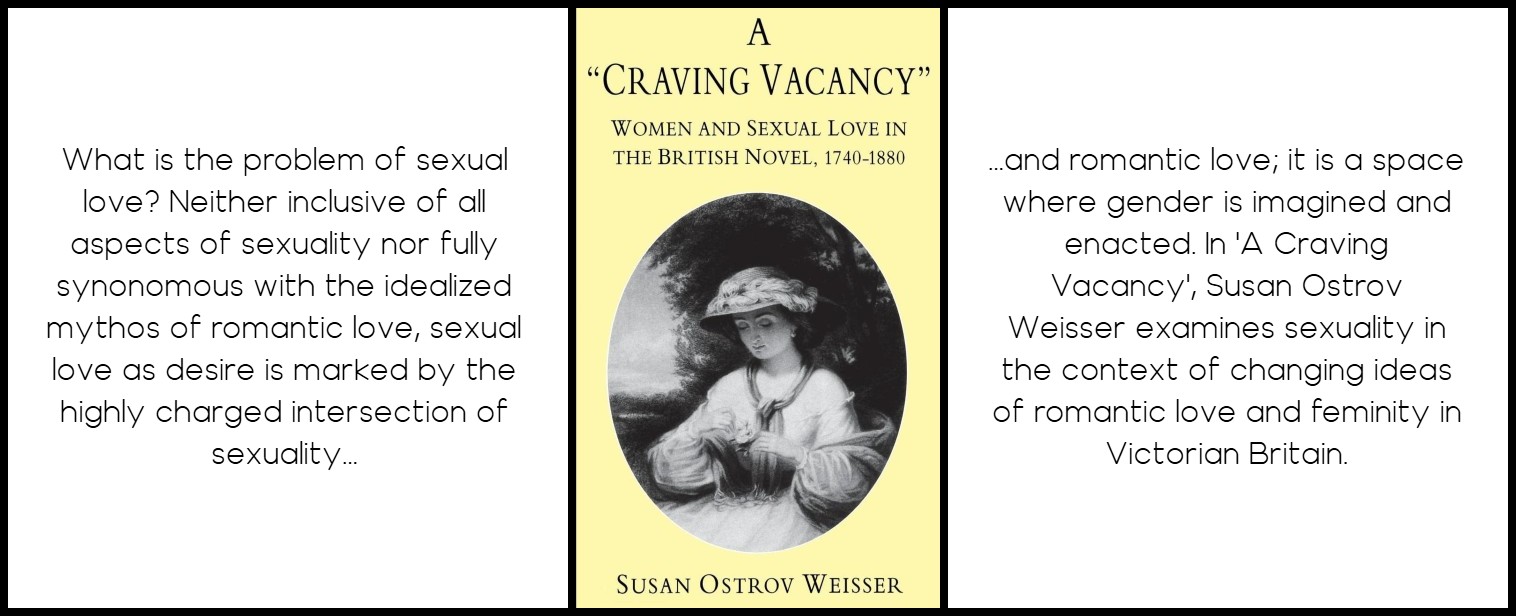
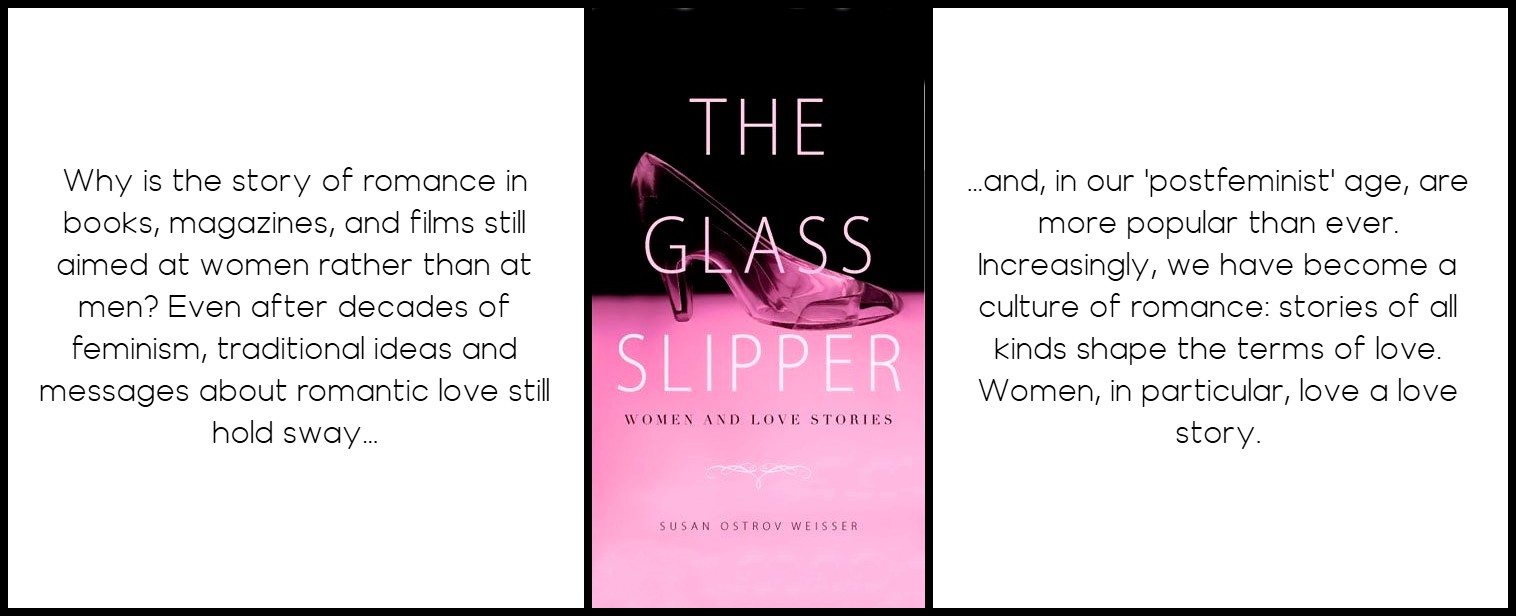
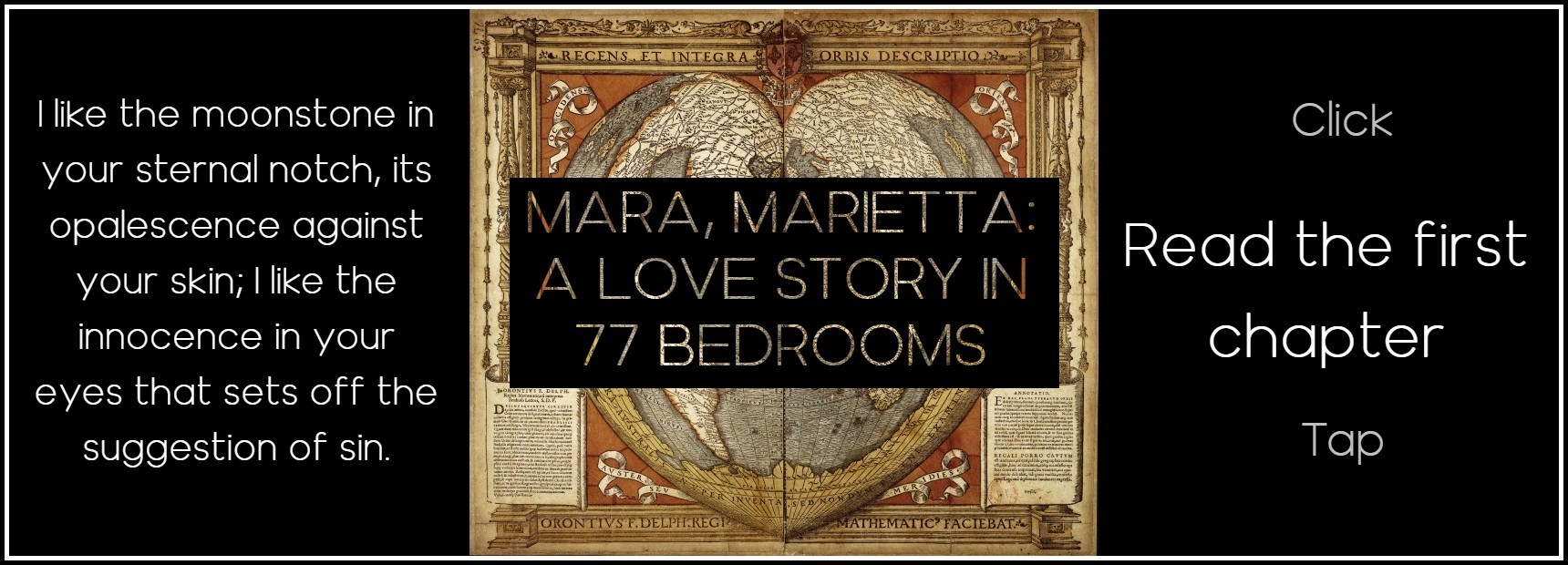
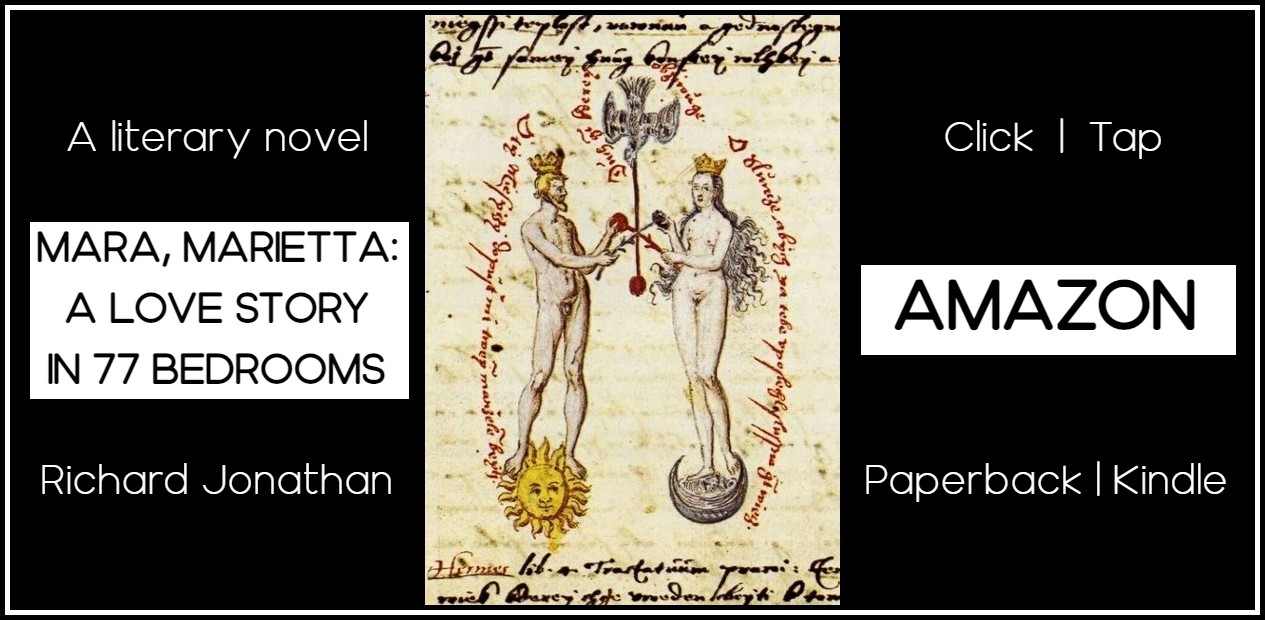


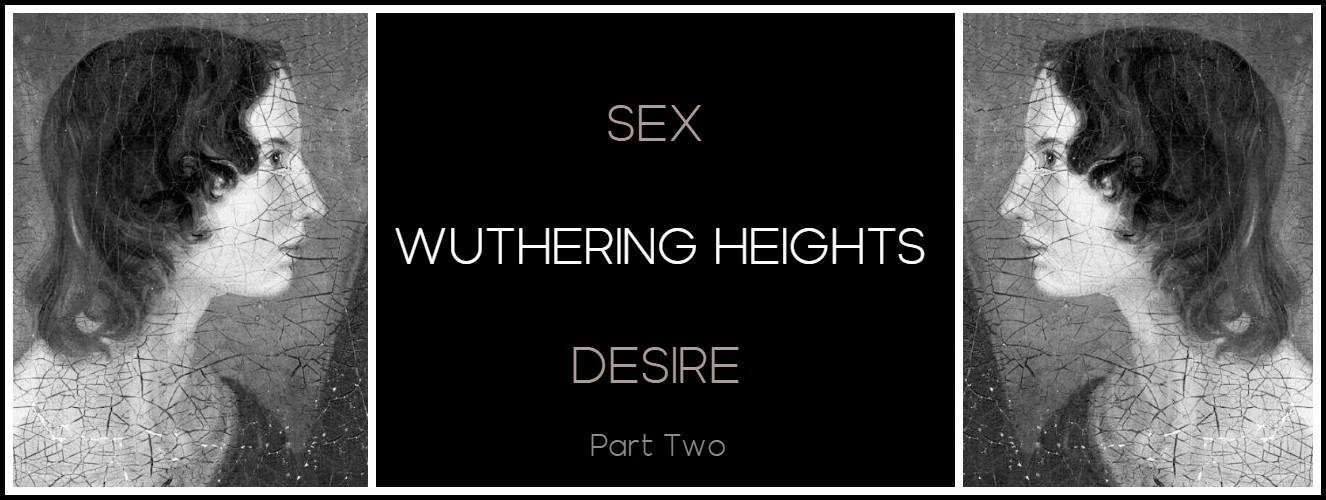
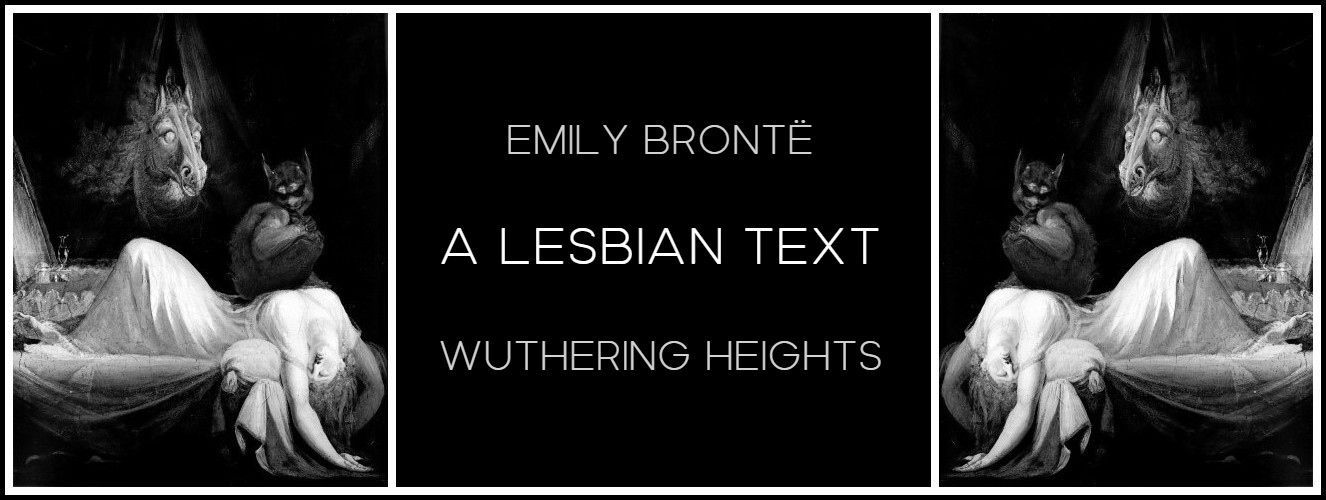
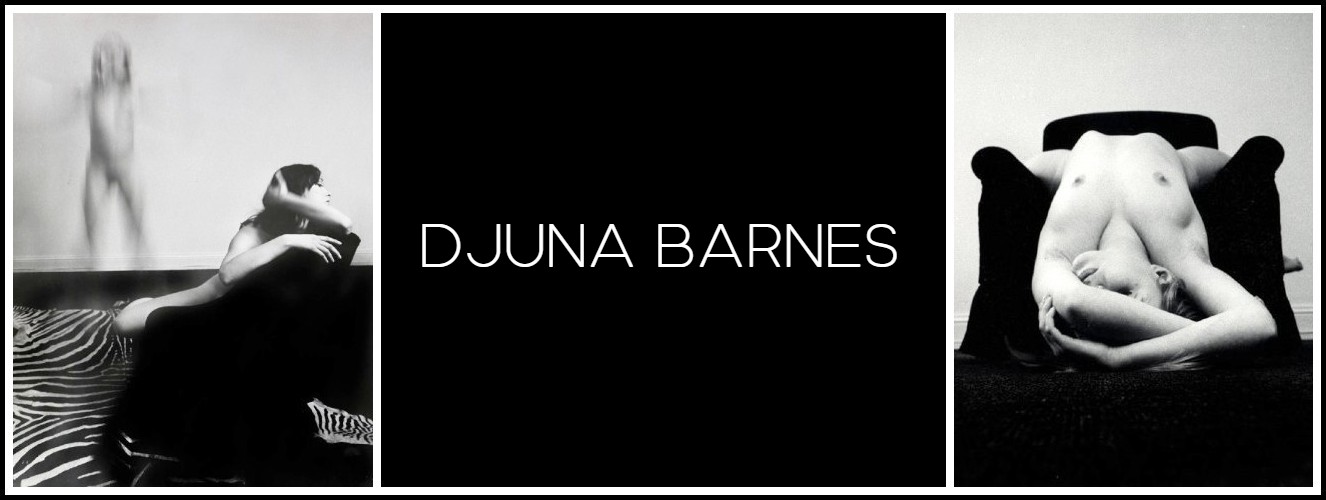
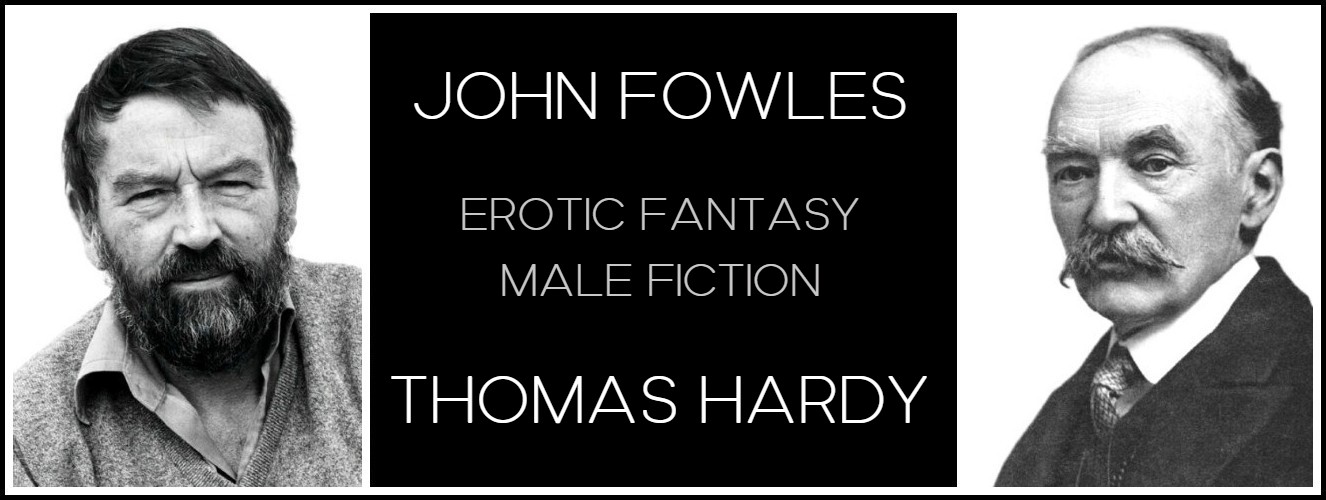
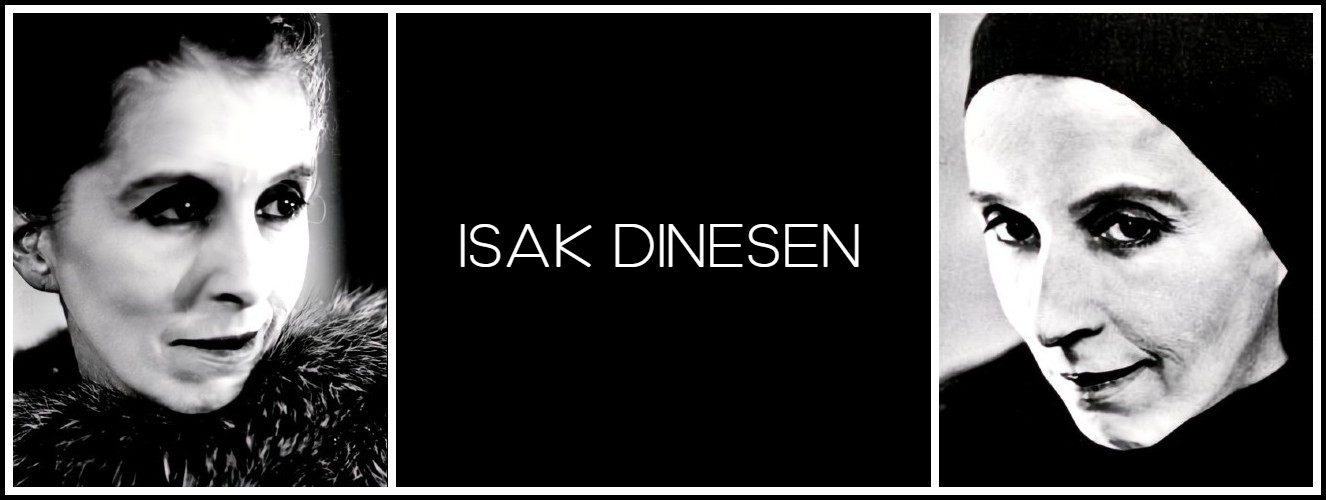
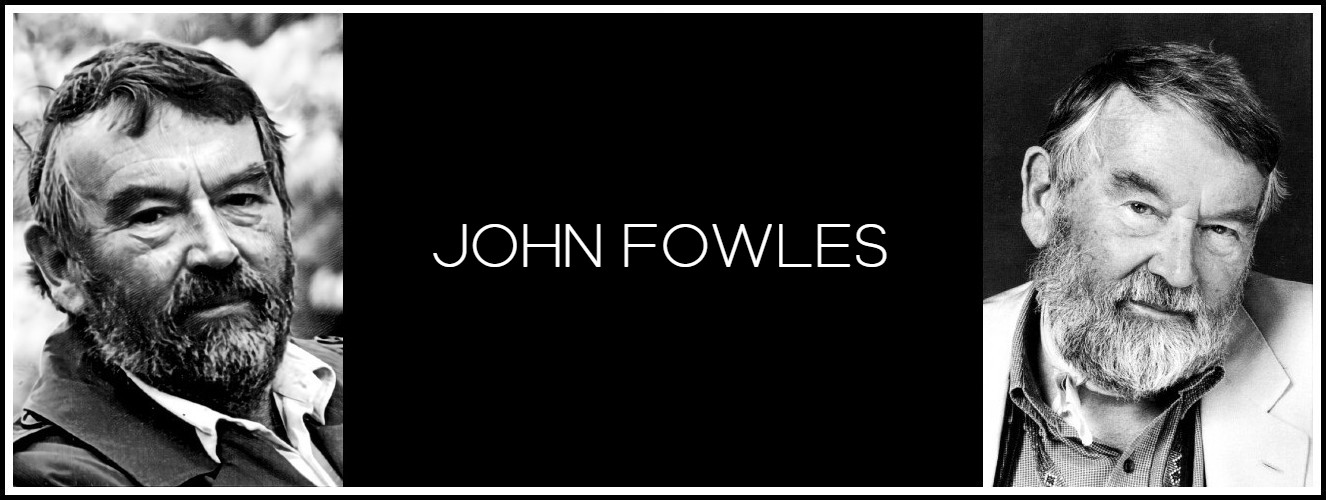
Comments